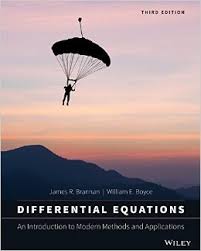Math 2080, Fall 2015
Math 2080, Fall 2015

Class: Introduction to Ordinary Differential Equations.
Instructor: Dr. Macauley
Resources
Lectures and Worksheets
When I taught Math 2080 online, I made 48 lectures which are posted on
YouTube. I am linking to them here to serve as a supplemental
resource, with the understanding that they are not intended as
a substitute for coming to class. Rather, they should be used if you
want to re-watch a particular example or concept, or if you have to
miss class due to illness. To avoid blurriness, these are best viewed
by changing the settings to 720p (High Definition) rather than the
default of 240p. This can be easily done by clicking the "wheel" on
the lower right corner; right next to the "cc" button.
Section 1: Introduction to Ordinary Differential
Equations. Modeling physical situations that exhibit exponential
growth and exponential decay. Plotting slope fields using the isocline
method. Sketching slope fields of autonomous differential
equations. Approximating solutions using Euler's method.
Lecture notes. 9 pages, last updated 1/21/11. Brannan/Boyce: Sections 1.1--1.3, 2.3, 8.1, supplemental material.
- Lecture 1.1: What is a differential equation?
[YouTube (26:03)
| Worksheet]
- Lecture 1.2: Plotting solutions to differential equations.
[YouTube (29:36)
| Worksheet]
- Lecture 1.3: Approximating solutions to differential equations.
[YouTube (27:38)
| Worksheet]
Section 2: First Order Differential Equations. Solving 1st
order ODEs using separation of variables, the integrating factor
method, and variation of parameters. Structure of solutions to 1st
order linear ODEs, and connections to parametrized lines. Models of
motion with air resistance. Mixing problems. The logistic equation as
a population model.
Lecture notes. 21 pages, last updated 2/17/11. Brannan/Boyce: Sections 2.1--2.6.
Section 3: Second Order Differential Equations. Models that use
2nd order ODEs. Solving homogeneous linear 2nd order ODEs. Solving
inhomogeneous ODEs using the method of undertermined
coefficients. Simple harmonic motion. Harmonic motion with damping and
with forcing terms. The variation of parameters method for 2nd order
ODEs. Solving 2nd order non-constant coefficient ODEs. Cauchy-Euler
equations. The power series method, and the theorem of
Frobenius.
Lecture notes. 29 pages, last updated 2/17/11. Brannan/Boyce: Sections 4.1--4.7, 9.1--9.6.
Section 4: Systems of Differential Equations. Intro to
linear algebra: Adding and multiplying matrices. Writing systems of
linear equations with matrices, inverses and determinants of 2x2
matrices, eigenvalues and eigenvectors of 2x2 matrices. Using linear
algebra to solve systems of two 1st order linear ODEs x'=Ax; 3 cases
(i) real distinct eigenvalues, (ii) repeated eigenvalues, (iii)
complex eigenvalues. The SIR model in epidemiology.
Lecture
notes. 26 pages, last updated 10/20/10. Brannan/Boyce:
Sections 3.1--3.6, 4.7, A.1.
- Lecture 4.1: Basic matrix algebra.
[YouTube (57:55)
| Worksheet]
- Lecture 4.2: Eigenvalues and eigenvectors.
[YouTube (38:28)
| Worksheet]
- Lecture 4.3: Mixing with two tanks.
[YouTube (29:55)
| Worksheet]
- Lecture 4.4: Solving a 2x2 system of ODEs.
[YouTube (39:27)
| Worksheet]
- Lecture 4.5: Phase portraits with real eigenvalues.
[YouTube (27:30)
| Worksheet]
- Lecture 4.6: Phase portraits with complex eigenvalues.
[YouTube (47:10)
| Worksheet]
- Lecture 4.7: Phase portraits with repeated eigenvalues.
[YouTube (37:24)
| Worksheet]
- Lecture 4.8: Stability of phase portraits.
[YouTube (51:07)
| Worksheet]
- Lecture 4.9: Variation of parameters for systems.
[YouTube (coming soon)
| Worksheet]
Section 5: Laplace Transforms. Definition and properties of the
Laplace transform. Using Laplace transforms to solve ODEs. Using the
Heavyside function to express, and take the Laplace transform of,
piecewise continuous functions. Solving ODEs with discontinuous
forcing terms. Taking the Laplace transform of periodic
functions. Impulse functions and delta functions. Convolution.
Lecture notes. 21 pages, last updated 6/24/13. Brannan/Boyce: Sections 5.1--5.8.
Section 6: Fourier Series & Boundary Value Problems. Introduction to Fourier series -- derivation and computation. Even and odd functions, and Fourier cosine and sine series. Complex version of Fourier series. Parseval's
identity. Applications to summing series and to solving ODEs. Boundary values problems.
Lecture notes. 13 pages, last updated 12/9/11. Brannan/Boyce: Sections 10.1--10.3.
Section 7: Partial Differential Equations The (1-dimensional)
heat, transport, and wave equations. Analysis of different boundary
conditions. Introduction to PDEs in higher dimensions. Harmonic
functions, Laplace's equation, and steady-state solutions to the heat
equation. Solving Laplace's equation, the heat equation, and the wave
equation in two dimensions.
Lecture notes. 23 pages, last updated 7/29/10. Brannan/Boyce: Sections 11.1--11.4, 11.6, 11.A, 11.B
Section 8: Systems of Nonlinear Differential Equations The SIR
model in epidemiology. Models for competing species and predatory-prey
equations in population dymamics. Linearizing a nonlinear system at
steady-state solutions.
Lecture notes. 14 pages, last updated 12/3/15. Brannan/Boyce: Sections 7.2--4, 7.P.1
